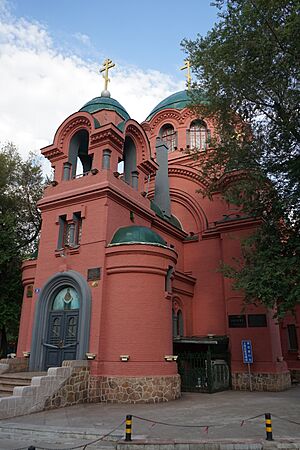Chinese Orthodox Church facts for kids
Quick facts for kids Chinese Orthodox Church |
|
|---|---|
| 中华东正教会 | |

Church of the Intercession, Harbin
|
|
| Abbreviation | COC |
| Classification | Eastern Orthodox |
| Bishops | 0 |
| Parishes | 13 |
| Liturgy | Byzantine Rite |
| Territory | People's Republic of China |
| Members | 15,000 |
The Chinese Orthodox Church is a Christian church in China. It is part of the Eastern Orthodox Church, which is one of the oldest Christian groups in the world. This church has its own leaders and makes its own decisions, but it is still connected to the larger Orthodox family.
Orthodox Christianity has been present in China since the 1600s. It started with help from the Russian Orthodox Church. In 1957, the Russian Church gave the Chinese Church the right to be independent.
Contents
Early Christianity in China
Some people believe that Christianity first came to China around 68 AD. This was possibly through the apostle Thomas, who also traveled to India. There is also some thought that early Christians from the Church of the East visited China much later.
The oldest clear proof of Christianity in China comes from the 600s. This was also from the Church of the East. We know this from a special stone monument called a Nestorian Stele and a building called the Daqin Pagoda in Xi'an. This early form of Christianity faced difficulties and nearly disappeared in the 900s. It was brought back in the 1200s but faded again when the Chinese Ming dynasty began in the 1300s.
The Russian Orthodox Mission

The Russian Orthodox Church began sending missionaries to China in the late 1600s. At first, this was mainly to help Russian people living in China. Some Russian soldiers, called Cossacks, settled in a place called Albazin. When Chinese forces attacked Albazin, some Cossacks joined the Chinese army.
After a peace agreement in 1689, Russian traders were allowed to visit Beijing. This led to closer ties with the Russian Church. In the early 1700s, the Russian leader Peter the Great wanted to send priests to China. He hoped they would learn Chinese and help Russia's interests. The first Russian priests arrived in Beijing in 1713.
The first official mission was set up in Beijing in 1715. The Chinese government later allowed the Russians to build an Orthodox chapel. Over time, the mission became known for its studies of Chinese culture. Two famous scholars from the mission were Iakinf and Palladius (Kafarov). Palladius even created a Chinese dictionary.
The Boxer Rebellion's Impact
From 1898 to 1900, a group called the Boxer Rebellion caused trouble in China. They attacked foreign missionaries and Chinese people who had become Christians. The Russian mission suffered a lot, and its library in Beijing was burned.
The Orthodox Church remembers 222 Chinese Orthodox Christians who were killed in 1900. They are called the Holy Martyrs of China.
Even after this difficult time, the church grew. By 1902, there were 32 Orthodox churches in China with almost 6,000 members. The church also ran schools and places for orphans.
The Chinese Orthodox Church Today
After the People's Republic of China was formed in 1949, the Russian Church wanted the mission to become a Chinese church. In 1957, the Russian Orthodox Church officially gave the Chinese Orthodox Church its independence. However, during the 1950s and 1960s, it became very hard for Christians in China. All public religious activities stopped by 1966 during the Cultural Revolution.
Since the 1980s, the Chinese government officially recognizes five main religions: Buddhism, Taoism, Islam, Catholicism, and Protestantism. The Orthodox Church is not yet officially recognized in the same way. However, China and Russia have been working together to help the Chinese Orthodox Church grow again.
As of August 2025, there are only three places in mainland China where Orthodox services happen regularly with priests. These are in Beijing (at the Russian Embassy), Shanghai (at the Russian Consulate), and Church of the Intercession, Harbin. The church in Harbin is the only one open to Chinese citizens for regular worship. In other areas, like Northeast and Western China, small groups of Orthodox Christians meet without a priest, and the government seems to allow this quietly. There are also Orthodox groups in Guangdong province and Shanghai. Two old Orthodox churches in Shanghai are in the process of being returned to the church.
In March 2018, the Chinese Orthodox Church received permission from the government to train new priests in Russian seminaries.
The Orthodox Church operates more freely in Hong Kong. There are two Orthodox churches there. There is also an Orthodox presence in Taiwan.
Orthodox Evenks
The Evenks are a group of people who live in both Russia and China. Many Evenks are Orthodox Christians. They chose this religion themselves. There are about 3,000 Evenks living in the Heilongjiang area of China.
See also
 In Spanish: Iglesia ortodoxa china para niños
In Spanish: Iglesia ortodoxa china para niños
- Christianity in China
- Albazinians
- Harbin Russians
Images for kids
-
Former Orthodox church in Wuhan



